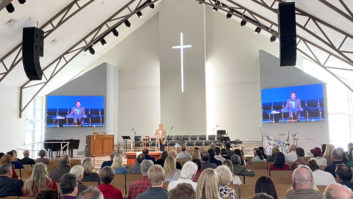
With no shortage of new-builds and renovation projects underway, the worship market becomes evermore crucial to the overall health of pro AV. But protracted lead times, variable end-user skill-sets and acoustically problematic installs mean that it’s one that doesn’t necessarily lead to unalloyed hallelujahs, writes David Davies.
“God’s away on business,” sang Tom Waits with characteristically raspy emphasis on his 2002 album Blood Money. But for many professional audio manufacturers and installers, God has been very much present, correct and doing good business over the last decade, with houses of worship affording an increasingly significant source of revenue.
The US remains the largest single market for HoW install, with the continued buoyancy of evangelical Christianity giving rise to numerous projects whose AV specification is frequently the equal of fully fledged concert halls or theatres. But Asia, too, is seeing a rapid rise in church attendance, not least in China. Notorious former ruler Mao Zedong famously wished to rid the country of religion, but now many leading academics believe that China could ultimately become the world’s most Christian nation. If that comes to pass, it’s going to mean a lot of new and refurbished churches.
The scale of projects in these regions is frequently dazzling, often encompassing “thousands of worshippers and the use of the top-of-the-range equipment”, says Michael Polten, director product marketing, Sennheiser. “For example, we have just concluded a 60-channel Digital 9000 [wireless mic system] agreement with a HoW in Indonesia. You will also find great stages, even broadcast stations within the HoW to transmit the services to even bigger audiences.”
Modern worship music styles are an important driver of change. “The use of contemporary music places increased demands on the sound system as compared to the ‘speech only’ systems used with more traditional worship in which piano, organ and choir form the musical experience,” says Alan Shirley, product line manager, sound reinforcement loudspeakers at Bose. “In fact, we see some US ‘megachurches’ with seating capacities of 3,000 or more install the same line array loudspeaker systems found on major concert tours and best-in-class performing arts centres.”
Such large-scale ‘mega-HoWs’ are comparatively rare in Europe, but here too the expectations of audio systems are gradually rising. But with different denominations having varying requirements, and the scope and scale of projects being determined to a large degree by the availability of (congregation-backed) funds, it’s a market that has its own inescapable challenges. Just ask Iain Harvey-Smith, communications director at DM Music, a Hertfordshire-based audiovisual installer specialising in worship-based projects.
For a start, says Harvey-Smith, generalisations about requirements are difficult to apply since the HoW market is “complex and diverse, covering many differing denominations, worship styles, demographics and architecture. Then there are the lead times – our average from first visit to installation is about one year, but our record is seven years. So to work in this area takes a lot of time and requires experience, patience and understanding.”
Accommodating variable end-user skill-sets is another challenge, although Harvey-Smith is one of several interviewees to suggest that the overall level of background knowledge has increased in recent years. But the point goes to underline the extent to which a detailed knowledge of HoW specifics is essential to achieving traction in this market.
Give very careful consideration to system type
For DM Music, nearly all of its projects relate to Christian houses of worship, with recent credits including cathedrals in Sheffield and Wakefield, but even in that context there are many variables that can come into play. So letting the specific requirements of church services determine the choice of system is vital, says Harvey-Smith.
“Standard questions would include: is it a speech-based sound reinforcement system? Does it require background music as well? Or does it involve an orchestra, choir or full band? Sometimes it’s all of these,” he says.
Alongside the obvious need for the spoken word to be clear and intelligible at all times, music has risen up the priority list. “The majority of churches wanting to spend money on improving what they have are generally driven by the music side,” says Steve Jones, who provides education and application support at d&b audiotechnik. “These days, music is more an important part of church services – one that we have had to satisfy by putting in an increasing number of rock & roll-style PAs.”
In older churches, system specification will also be informed by other environmental and what might we might term ‘legacy’ factors. “If it’s a listed building, then changes to the fabric will need to be approved by the diocese,” says Harvey-Smith. “Architectural and historical sensitivities, as well as aesthetics, will be considered and can hamper favoured locations for equipment. On a related note, acoustics and reverberation times are always a consideration, too.”
Acoustic issues can also vary substantially in more recently built venues. “How acoustically challenging a purpose-built church is will depend on if it has been designed from the ground up to have high-quality acoustics and, if not, the budget to add acoustic improvements – whether at the time of construction or subsequently,” says Karl Christmas, sales and marketing manager at Yamaha Commercial Audio (UK & ROI).
Console-wise, the ability of digital consoles to deliver value for money and extensive feature-sets has increasingly led them to supplant their analogue counterparts. The ability to ‘lock out’ features for less experienced operators can also be an asset.
“All of our digital consoles – iLive, GLD and Qu – offer multiple levels of user permissions,” says Nicola Beretta, senior product manager, Allen & Heath. “Yes, there are some ace engineers in houses of worship, but there are also many volunteers who find themselves at the helm of increasingly sophisticated AV systems. By offering different levels of control we allow the installer and advanced user to get the best from the system, but it can also be password-protected and set in a more restricted mode, which gives the novice user greater confidence.”
In terms of loudspeakers, the latest generations of beam-oriented and column speakers have allowed the provision of audio that is more carefully targeted towards congregations – and consequently away from unsympathetic surfaces.
“Even [in the case of] HoW venues with new construction, most [require the specification of] a loudspeaker with good coverage control to minimise unwanted reflections from walls, ceilings and floors, to provide excellent vocal clarity and intelligibility,” says Shirley.
TC Group brand Tannoy is another manufacturer that has sought to cater to the contrasting acoustic environments of HoWs. Ivan Schwartz, TC Group western regional sales manager for install and tour, comments: “From the smallest to largest rooms we can provide accurate and musical-sounding systems. In the case of QFlex with a digitally steerable column system, we not only provide high speech intelligibility and music reinforcement in acoustically difficult environments, but again in a pleasant-sounding system.”
www.allen-heath.com
www.bose.com
www.dbaudio.com
www.dmmusic.com
www.l-acoustics.com
en-uk.sennheiser.com
www.yamahaproaudio.com







